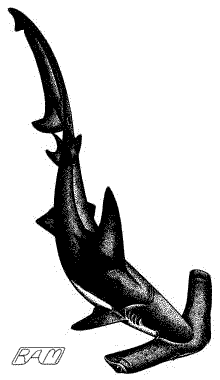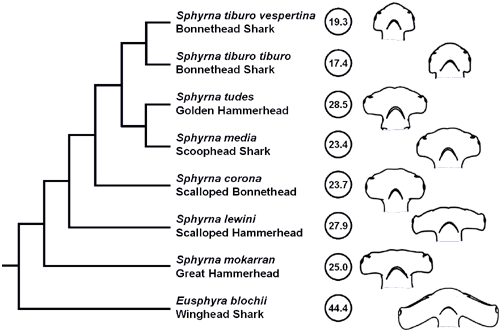Origin and Evolution of the 'Hammer'
The shark fossil record suggests a common pattern of rapid diversification followed by long periods of gradual change along separate lineages. Additional evidence for this evolutionary trend has come from a surprising new direction: sequences of nucleotide bases in mitochondrial DNA (mtDNA).
 Consider the
example provided by the wonderfully bizarre hammerhead sharks. The eight species
of hammerhead are among the most easily recognizable of sharks. To a greater or
lesser extent they all have elongated, flattened lobes projecting from the sides
of the head. These lobes contain specialized muscles and connective tissue and
are supported by unique lateral expansions of the orbital and nasal regions of
the cartilaginous skull. In every other respect, however, hammerheads resemble
the whaler sharks (family Carcharhinidae). This similarity has generated a great
deal of speculation and debate about how such decidedly odd headgear might
evolve.
Consider the
example provided by the wonderfully bizarre hammerhead sharks. The eight species
of hammerhead are among the most easily recognizable of sharks. To a greater or
lesser extent they all have elongated, flattened lobes projecting from the sides
of the head. These lobes contain specialized muscles and connective tissue and
are supported by unique lateral expansions of the orbital and nasal regions of
the cartilaginous skull. In every other respect, however, hammerheads resemble
the whaler sharks (family Carcharhinidae). This similarity has generated a great
deal of speculation and debate about how such decidedly odd headgear might
evolve.
The 'hammer' of these sharks comes in a more-or-less continuous spectrum of sizes, from the modestly adorned Bonnethead (Sphyrna tiburo), through the middle-of-the-road Great (S. mokarran) and Scalloped (S. lewini) hammerheads, to the seemingly ridiculous extreme of the Winghead Shark (Eusphyra blochii). Further, the hammerheads seem to most closely resemble the carcharhinid Scoliodon laticaudus, also known as the Spadenose Shark. It had traditionally been thought that all the hammerheads evolved from a single carcharhinid ancestor with a 'normal-shaped' head. It was further surmised that the hammer had evolved gradually, expanding sideways bit-by-bit over millions of years. Therefore, it was deduced that the Bonnethead Shark is the most ancestral species, the Winghead the most derived, and the other hammerheads somewhere in between. It all seemed to make flawless, intuitive sense. But Nature is rarely as simple as human ideas about how it 'works'.
Geneticist Andrew Martin used mtDNA sequence data to explore the origins and pattern of hammer development in seven species (including two sub-species) of hammerhead shark. Martin's results supported the common-sense idea that the hammerheads constitute a monophyletic group (sharing a common ancestor) derived from the carcharhinids, but also revealed some surprises. The molecular data strongly suggest that the Winghead Shark — not the Bonnethead — was the first hammerhead to diverge from the group's common ancestor and that the bonnethead was, in fact, the most recent hammerhead to appear. Furthermore, the same data suggest that the relative size of the hammer fluctuated slightly between wider and narrower in closely-related species rather than showing any clear trend. The cladogram (branching diagram) below is based on one Martin presented in a short 1993 paper. It shows the branching sequence of the eight hammerhead taxa sampled and the average head width expressed as a percentage of body length (for comparison, in most carcharhinids, head width averages about 6-8% of body length).

These data led Martin to conclude that, in hammerhead sharks, the hammer appeared rather suddenly and fully formed, and was later optimized along different lines to suit various selection pressures. This interpretation is further supported by morphological details of the hammer in various species of hammerhead shark. In the Winghead Shark, the nostrils are closer to the midline of the hammer than to the outer tips. In all other hammerheads, the nostrils are near the tips of the hammer. This change in the location of the nostrils may enable later hammerheads to sample a wide portion of the water column for attractive odors and thereby increase olfactory acuity. Similarly, the pattern of ampullae of Lorenzini (electroreceptive organs) on the undersurface of the hammer in the Winghead Shark is concentrated almost exclusively near the midline, while in other species of hammerhead these organs are spread more fully over the undersurface of the hammer. These modifications of the hammerhead 'hammer' may take advantage of opportunities for sensory enhancement afforded by the evolutionary novelty which first appeared in the Winghead Shark.
NOTE: A similar pattern of rapid diversification followed by a winnowing down of unsuccessful evolutionary experiments through natural selection may explain the apparent history of lamnoid sharks as suggested by the fossil record.
